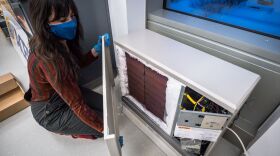-
Plans by the Native Village of Kotzebue to sell wind power to its local electric cooperative are on hold after the federal government slashed a $150 million grant for Alaska tribal infrastructure projects earlier this month.
-
Infrastructure projects across the country are in limbo after the Trump administration placed a sweeping 90-day hold on federal grant and loan programs. For the Northwest Arctic, this jeopardizes millions of dollars for previously funded energy projects and could further delay them for at least a year.
-
“The idea of the tribally-owned energy project is to have more control locally over the price of energy, and to be able to produce as much energy locally as we can, reducing the amount of diesel fuel we use for electricity,” said Chad Nordlum, the energy project manager for the Native Village of Kotzebue.
-
Mathiasson called the borough’s renewable energy plan, now 15 years in the making, a “success story” in energy sovereignty for rural Alaska.
-
Pride said the mission of the study — which is part of the NSF’s Navigating the New Arctic program — is to find ways to reduce dependence on heating oil in Alaska, especially in colder, rural regions where winter heating bills can be astronomically high.
-
Edwin Bifelt said even with state support, energy in rural Alaska remains pricey.“Even with Power Cost Equalization, people see rates anywhere from 20 cents up to 40 to 50 cents a kilowatt-hour, which is four or five times the national average,” Bifelt said.
-
It will be the largest solar project in rural Alaska, and second statewide to the 1.2 megawatt solar farm in Willow.
Play Live Radio
Next Up:
0:00
0:00
Available On Air Stations







